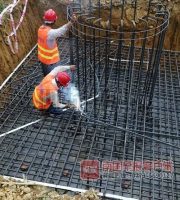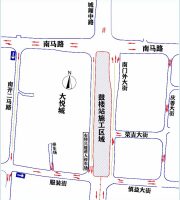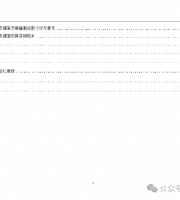2.
Whether the invoice is issued or obtained, check whether it meets the requirements.
.
If the falsely issued amount is relatively large, the enterprise will face fines, and the relevant responsible persons will be investigated for criminal responsibility.
At the same time, the enterprise should register the payment time agreed in the contract, actively urge the payment and issue invoices in time after the payment is due.
1、 Main tax-related risks and control measures related to taxes (I) Risks in value-added tax 1.
Construction enterprises mostly adopt the internal contract responsibility system for projects, and the project manager responsibility system management mode for projects.
For projects with simple tax calculation, VAT is prepaid locally based on the difference after deducting the subcontracting amount.
2) If the cost composition of the project, such as the amount of materials, machinery and labor services, is seriously inconsistent with the target cost and market information, the tax authority will track down the invoicing party for confirmation based on the rationality of the cost.
(1) Main tax-related issues.
3) The risk of the company being identified as false due to the supplier’s tax inspection.
For projects that adopt general tax calculation, apply for tax compensation in the place where the institution is located after 2% of the difference is prepaid in the project area.
For example, a supplier specially set up to resell invoices may not send the invoice information for inspection after issuing the VAT invoice or cancel it later, which will lead to tax inspection, and then involve the ticket-taking party.
The tax risk and control of the construction tax burden of the VAT invoice obtained or issued that does not meet the requirements are closely related to whether the VAT input tax invoice can be obtained during the project operation and the project control.
If the invoicing party does not handle it properly, it will face the risk of being identified as a false invoice.
If the payment time is delayed by the agreement of both parties, a supplementary agreement should be signed in time, so as to determine the time of the tax obligation and issue invoices according to the new payment time, and prevent the late payment penalty from being charged due to the tax delay.
The company’s finance department reports and pays taxes for each project after summary, including enterprise income tax, value-added tax, urban construction tax, education surcharge, stamp tax, personal income tax, property tax, urban land use tax, and vehicle and ship tax.
In this case, if no invoice is issued, the tax liability has not occurred, and there is no need to declare and pay value-added tax.
It is also necessary to obtain the subcontract invoice and the input tax invoice of suppliers such as materials and machinery in a timely manner to avoid the large amount of tax paid in the early stage and the large amount of tax left to offset the risk in the later stage.
Both cases are false invoices, and risks should be carefully prevented.
Otherwise, it may bring economic and legal risks such as increased project costs, false issuance of special VAT invoices, etc.
The main risk points are value-added tax, corporate income tax, personal income tax and invoice management.
36 document, the time of value-added tax liability in the construction industry shall be determined according to the principle of the first of invoicing time, collection time and payment time agreed in the written contract.
If the Employer does not receive the VAT invoice, it shall make tax declaration on the income without invoice to avoid being checked and punished in the later tax inspection.
It is necessary to timely clear the subcontracting settlement amount and obtain the subcontracting invoice to avoid excessive withholding tax due to the inability to deduct the total amount by the difference at the later stage of subcontracting.
It will also be identified as a false invoice and face corresponding punishment.
Countermeasures: For the project that has reached the payment period but has not yet been paid by the Employer, it shall communicate with the Employer, issue VAT invoices and pay VAT in time.
For example, the invoice should have been obtained from the subcontractor enterprise A, but it was obtained from the supplier enterprise B of enterprise A, knowing that it did not meet the requirements; The invoice should have been issued to C, but it was issued to D who has business relations with C.
The enterprise is obliged to obtain the legal and compliant VAT special invoice.
If it is difficult to obtain the supplier’s input tax invoice due to financial problems, it is necessary to actively negotiate with the supplier, pay the relevant taxes in advance, and timely obtain the subcontract invoice and input tax invoice for certification and deduction.
In the case that the quantities have been confirmed but the Employer has not yet paid, according to the payment time agreed in the contract, there are two cases: one is that the payment time has arrived according to the contract, but the Employer has not yet paid, in this case, the VAT liability has occurred, and the invoice should be issued and the VAT should be declared and paid; The second is that the payment time agreed in the contract has not yet arrived, and the Employer has not paid.
4) The business is true but the invoices obtained or issued do not conform to the regulations, resulting in tax-related risks.
Invoices that do not comply with tax regulations cannot be used as pre-tax deduction vouchers.
Risks and control measures of failing to declare and pay value-added tax in time in case of tax liability According to the CS [2016] No.
According to the regulations on the management of invoices and the handling of false VAT invoices, the issuance of invoices for others or for themselves that are inconsistent with the actual business situation and the purchase of VAT invoices that are inconsistent with the actual situation can constitute false invoices or false invoices.
They adopt centralized accounting and summary tax payment.
Construction enterprises are mainly faced with the following tax-related risks: 1) The business risk of falsely issuing VAT invoices due to improper management.




